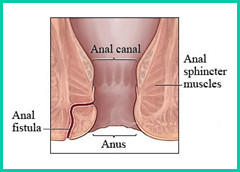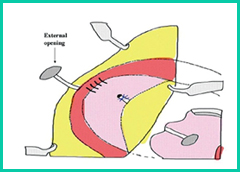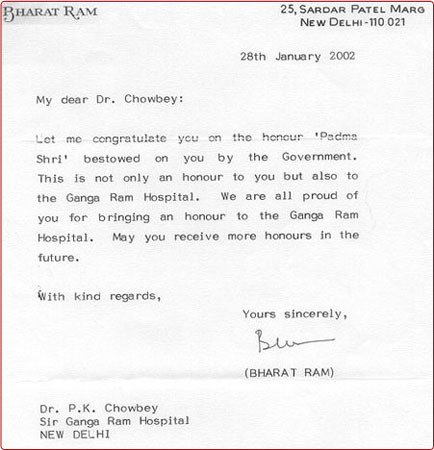What is Anal Fistula?
- A fistula is known as the connection of two body cavities or as the connection of a body cavity to the skin, which is not a normal occurrence.
- Anal fistula, or fistula-in-ano, is a common anorectal problem in which an abnormal connection develops between the inner surface of the anal canal and the skin around the anal verge.
- Due to blockage of the outlet of the anal glands which cause secretions to accumulate inside and an abscess forms the anal fistula.

Anal Fistula
- Fistulotomy / Fistulectomy represent the current gold standard in achieving these goals to surgically treat fistulas with a minor involvement of the sphincters. The minimal invasive technique for treatment of anal fistula is also one of the most popular alternatives to Fistulotomy / Fistulectomy.
Fistulotomy/ Fistulectomy
What is it?
Both these processes require open surgery of the anal fistula. The choice between both these processes is highly dependent on the region where the fistula lies and the portion of anal sphincter it crosses.
- Lay-open of fistula in ano tract (fistulotomy). The fistula tract is cut open leaving a raw wound. This wound requires daily dressings and is painful.
- Excision of entire fistulous tract (fistulectomy). A probe or dye inserted into the tract from one opening to the other defines the entire tract.
- Then the tract is excised leaving behind a raw surface area which requires daily dressings till complete healing is achieved.

Anal Fistula

Anal Fistula
Benefits of Fistulotomy/Fistulectomy
- This methods best identify the fistula tract or path with its internal and external openings,
- Highly effective surgical treatment to destroy the fistula path,
- To preserve function of the anal sphincter (muscle which controls ability to pass stools).
Disadvantages of Fistulotomy/Fistulectomy
- Infection – this can result in an anal abscess and further surgery may be needed
- Damage to the sphincter muscles – this may affect the bowel control and can lead to faecal incontinence (Incontinence is associated with female sex, high anal fistula, type of surgery and previous fistula surgery)
- It requires prolonged period of painful dressing which may be extended for weeks or months.
- Narrowing of the anal canal (the short, muscular tube that connects the rectum with the anus)
- Re-occurrence – there is a chance that the fistula may recur in a significant number of patients.
Minimally-lnvasive anal fistula treatment (MAFT)
What is it?
- This is a minimally invasive laparoscopic technique used for treatment of anal fistula.
- This Video-assisted Anal Fistula treatment (VAAFT) in India is described as MinimaIly-invasive Anal Fistula Treatment.
- MAFT technique is performed for the surgical treatment of complex anal fistulas and their recurrences.
- The MAFT surgery experts in Delhi first examine the fistula path with an endoscope and determines the point of the internal opening of the fistula.
- The internal opening of the fistula is closed with the help of stapler and the entire path of the fistula is destroyed by electrocautery under direct telescopic vision.
Benefits of Minimally-lnvasive anal fistula treatment (MAFT)
- No surgical wounds on the buttocks or in the peri?anal region
- No damage to the anal sphincters
- Less pre-operative investigations to ascertain type of fistula
- Early recovery
- Can be done as a Day-Care procedure
- Possibilities of localization of the internal fistula opening (key point in all fistula surgical treatments)
- Fistulous tract can be completely destroyed from within, without damaging any other tissues
Disadvantages of Minimally-Invasive anal fistula treatment (MAFT)
- Though there are no such worth mentioning disadvantage of MAFT, but is has its own limitations.
- If the nature of the anal fistula is too complex then open surgical method is preferred over MAFT.
- In cases, the endoscope cannot reach to fistula that has penetrated to the anal sphincters, then again open surgical methods are considered.




